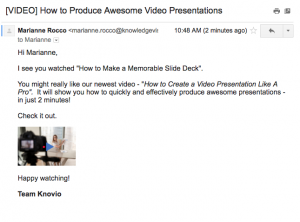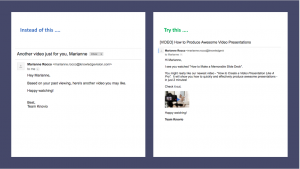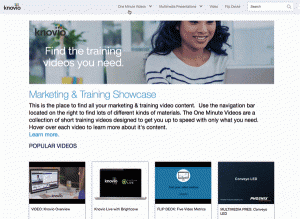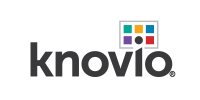Three Techniques to Get Your Learners to Watch More

Nowadays, trainers and corporate communications professionals have to think and act like marketers to drive engagement with their content. It’s not enough to create great content or training programs. You need to know how to get it discovered, read/watched/viewed, and then how to measure and track success. In other words, you need to write like a content creator and advertise like a marketer!
We spoke with more than a dozen of our most successful clients in leading Fortune 1000 companies to learn why, how and what was driving their success. And we uncovered some interesting similarities, regardless of the industry they serve. One thing was common: trainers who adopted a marketing mindset to ‘market’ their video presentation content continued to see greater qualitative and quantitative returns on their efforts, than those that stuck with the traditional meme of ‘build it and they will come’.
But before I share three common marketing techniques these brands use to engage their learners and employees, let’s review the why and what is driving the mind shift.
Why it’s necessary to think like a marketer.
Just like marketers, trainers, learning & development professionals and HR/corporate communication teams are tasked with effectively communicating with a varied audience. Cutting through the noise of information overload, finding a nano-second to grab someone’s attention, and providing valuable information and insight is hard. Marketers face this dilemma every day, and luckily have a few formulas to break-through and reach their audiences. So why not use what works?
What’s driving the shift?
The pace of change is wildly fast, and training global or distributed workforces is complex and expensive. There’s onsite instructor led training to schedule, on-demand training video presentations to create, and live webinars to produce. As the learner population morphs from Boomers to Gen-Xers, maximizing audience reach and engagement and matching learning styles to preferred content is a challenge. Although shifting, many ‘boomers’ prefer on-site, instructor led programs with traditional PowerPoints, and the younger generations prefer easy access to video-based content that feels personal. Finding the time, resources and budget to deliver different types of content is a balancing act. Luckily, technology is adapting to the market, and entire organizations are now adopting software and technology platforms to deliver effective and engaging blended training programs.
That’s the why and the what.
Here’s one of the three marketing techniques trainers and communications professionals are using to get their learners and employees to engage. Download the ebook to read all three.
#2 – Understand how your audience consumes content
There was a time when effective learning came from sitting in a classroom or watching a 60 minute slide presentation. Now, it’s all about ‘chunking out‘ content, so people can get what they need immediately. There’s a great need for simplifying technical and instructor led programs and delivering them in just-in-time modules in an on-demand medium. It’s not to suggest that in-person classroom training isn’t appropriate or effective. Rather, just-in-time modules complement classroom training and provide immediate learning.
Video is the perfect medium to deliver these ‘chunks’ of content. Our clients affectionately refer to this style of learning as video vignettes, snackable content, and learning nuggets. We all know it as just-in-time content. Just-in-time content is served best with one, two, or three-minute video clips. Nothing connects with audiences better than video and a story. It’s fast. It’s effective. It’s memorable.
Some of our clients are successfully requiring employees and learners to watch video vignettes or short video presentations as a prerequisite to attending on-site, live classroom training. Now that’s creative thinking- right? Get your viewers to consume and learn chunks of content before they attend a live instructor led session. It’s just like we are back in school with homework; but the beauty is, it doesn’t feel like homework.
An unexpected benefit in delivering this style of video training is real-time savings in time and money, as well as seeing faster results from training.
Incorporate web and email tactics to get them to watch.
Reaching your target audiences and getting them interested in new content is challenging even for marketers. But when you incorporate the tried and true channels of email and web, your life can get a whole lot easier.
Encourage viewer sign-in using links and buttons on your internal and external websites and portals. Send comprehensive training or HR newsletters at least once a month and send broadcast emails to notify viewers of newly posted videos, slide decks and materials. You could even incorporate banners to let viewers know new content is posted.
Several clients have seen great success with this technique and have anecdotally shared they’ve seen up-ticks in viewer interest and engagement of content when email campaigns are used regularly. And more than one client uses email to promote contests to encourage viewership.
The power of using web and email channels is that everything is trackable, so you know immediately when someone is engaged with a ‘first touch’ email or if they’ve logged into your training portal.
Design video or content portals for easy anytime access.
Video portals are a fast and easy way to share special collections of content for specific audiences. Use portals for onboarding, year-end materials, employee development. Anecdotally, our clients all agree that when you incorporate video with everyday communication there’s almost always a spike in engagement.
Five fast and easy ways to use targeted video portals include:
- new hire onboarding
- product training and reviews
- policies & process
- compliance materials
- live and on-demand corporate events
Create subscriptions and push notifications.
Every digital marketer knows the more relevant and requested content you can send to viewers, the more likely you’ll keep them engaged. Take a page from the best digital marketers and offer subscriptions to your content and provide content preferences to newly signed-up subscribers.
Personalize emails to encourage viewing.
Authenticity is essential to building trust and engagement with your viewers. One of the easiest ways to do that, is to make them believe you know and understand them. A first step? Add their first name (don’t forget to double check names for spelling and capitalization), maybe their job function, and what they last viewed. Although this can be a little bit creepy, there are friendly and positive ways to do it and your reader will feel more connected to you and your content.
For example:


Putting the marketing steps together.
There are lots of way of putting together a web and email approach to drive viewership and engagement. Digital marketers are doing it every day. Mix and match and A/B test to find the magic mix for you because every organization has different success metrics and personalities. Your success metrics may be to increase views, while some training goals may be to decrease the number of basic calls.
One approach that might work for you:
STEP ONE: Pull together your videos, flip-decks, and presentations in a video portal or showcase. Add multi-level categories to make it easy for viewers to find the content they need. Add new content as it comes available and remind viewers that helpful content is available.
STEP TWO: Send reminders through email and/or pop-ups. Keep your message short and to the point. Focus on the reason why someone should push play, rather than the traditional CTA – Watch Now. Send triggered reminders to those who view certain videos. This technique is much more relevant and personal, and typically garners more clicks.
For example:

STEP THREE: Remember to send monthly newsletters to remind your audience of new and popular content.
STEP FOUR: Consider creating a One-Minute Viewing Portal. The concept of just-in-time content is not new, but it’s really taking off according to our customers. Chunk out content from your longer videos and presentations and make it really easy to find and watch. You may be surprised at how fast someone gets through a module because you created relevant and snackable content.
Here’s how we highlight new video and one-minute portals:

—
Read the full case study with all the marketing techniques our clients are using to drive more engagement and maximize views with their training content.
